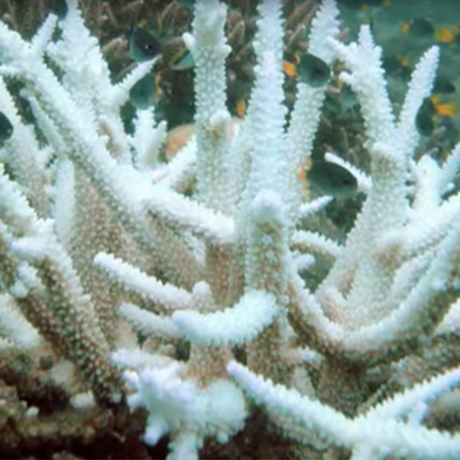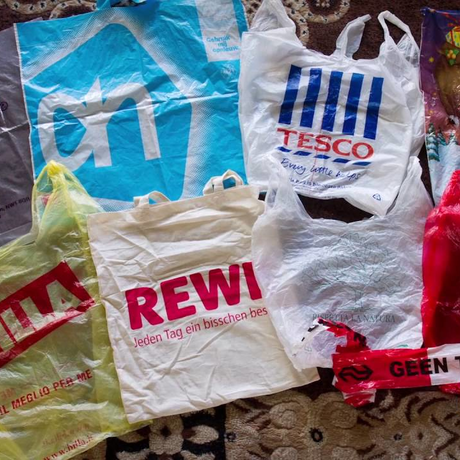
© Christian Hold
What kinds of everyday objects contain carbon? This introductory activity will help your students recognize where carbon is found, and will start you thinking about how it cycles through the environment.
Students will be able to:
- recognize that carbon is an extremely common element and can be found in many forms, in both living and non-living things.
- recognize that carbon moves between the Earth’s four spheres.
- articulate some ways that carbon impacts us and the earth.
- What Contains Carbon? worksheet (1 per student)
- seashell
- piece of wood
- plastic
- fabric
- carbonated beverage
- cup of water
- Collect the materials as a class set.
- Print out one worksheet for each student.
- Assess students’ prior knowledge of carbon via a class discussion or word map.
- As you explain its status as an element, highlight diamonds and graphite in their pencils as examples of pure carbon with vastly different properties.
- Explain that carbon combines easily with many other elements to form other substances with different properties. For example, carbon can combine with oxygen to form carbon dioxide (shake carbonated beverage or have them breathe out to highlight that it’s a gas).
- Let them know that carbon can be found in both living and non-living things. Today’s essential question: Do these everyday objects contain carbon, or not?
- Pass out a What Contains Carbon? worksheet to each student. At first, have students work individually to decide whether they think each object contains carbon or not. Emphasize that they need to provide an explanation for their conclusion.
- Divide students into six groups and assign each group an object. Have students come to a group conclusion about whether the object contains carbon and their explanation.
- Have each group report out. If the students don’t have a conclusion or the group is split, ask them how they could find out what the answer is.
- Guide students in understanding how each of the objects contains carbon, drawing from prior knowledge. See the teacher background section for details.
- Challenge students to look around the classroom from their seats and fill in the last three rows of the worksheet with other carbon-containing items in the classroom that they use on a daily basis.
- As a class, classify the objects into living and non-living groups, including things that used to be alive as living. (You can classify the seashell and the wood as living and the plastic, fabric, water, and carbonated beverage as non-living.)
- Discuss man-made objects like plastic, fabric, and the carbonated beverage. Discuss where the carbon in these objects comes from in order to emphasize how carbon can move around.
- The carbon in fabric may have come from living plants (cotton), petroleum (polyester or acrylic), or animals (wool or silk).
- Plastic came from hydrocarbons, which were formed millions of years ago from living things.
- CO2 in carbonated beverage is from the atmosphere.
Teacher Tip: For older students, you can introduce the specific terms for the earth’s four spheres, found in Carbon Cycle Role-Play, when discussing the movement of carbon.
- To further emphasize how carbon can move around, discuss how carbon might be released from the objects that you studied and where the carbon will go when you release it.
- Burning wood will release CO2 into the atmosphere.
- Shaking the carbonated beverage will release CO2 into the atmosphere.
- Seashell may be ground up into small particles by animals or physical forces and form sediment at bottom of ocean.
Assessment Boundary: If you are working towards Performance Expectations 5-LS2-1 or MS-LS2-3 regarding developing a model to describe the movement of matter among living and non-living parts of an ecosystem, remember that students are not expected to demonstrate understanding of molecular movement or describe the process using chemical reactions.
Explain that carbon is necessary for life, but can also have negative consequences. Draw a T-chart on the board and have students generate ideas.
Teacher Tip: An example is below, but don’t aim to end with these examples. Consider going back to this chart throughout the unit to engage your students in evaluative argument.
How does carbon help the planet?
- Carbon is an important element in living things.
- Plants need carbon dioxide to photosynthesize and grow.
- Carbon dioxide in the atmosphere keeps the planet warm and livable.
- Some of the things we use everyday contain carbon.
How does carbon hurt the planet?
- Too much carbon dioxide in the atmosphere changes the climate.
- Too much carbon dioxide dissolving in the ocean makes it more acidic. Many marine organisms make their skeletons out of calcium carbonate. They may decline and their ecosystems may be affected.
- Plastic can accumulate in nature as pollution.
This can be a stand-alone activity for younger grades. It is also a great introductory lesson for the rest of the Carbon Cycle Unit: Carbon Cycle Role-Play and Carbon Cycle Poster.
carbon: an element that can be found in all living things
carbon dioxide: a chemical compound composed of two oxygen atoms bonded on either side of a carbon atom (CO2); usually present as a gas
hydrocarbon: a chemical compound containing hydrogen and carbon and often occurring in fossil fuels
calcium carbonate: CaCO3; a white, chalky substance
Carbon is an important element for life on earth. Elemental carbon can be found in different forms having vastly different properties. For example, consider the different hardness and opacity of diamonds and graphite (the lead in pencils).
Carbon is present in all four major spheres of the planet: biosphere (the parts of the land, sea and atmosphere in which life can exist), hydrosphere (all of the Earth’s water), atmosphere (the gases surrounding the Earth), and lithosphere (rocky outer layer of Earth). Carbon is present in the living and non-living parts of the earth. Carbon makes up approximately 50% of all living tissues. Carbon is also found in rocks, atmospheric gases, and water.
Besides the relatively small additions of carbon from meteorites, the amount of carbon on the earth is stable. The amount of carbon contained in any of the earth’s spheres does not remain there forever. Instead, it moves from one sphere to another in an ongoing process known as the carbon cycle. For plants and ocean animals, it is important for there to be certain levels of carbon in the atmosphere and ocean.
Carbon in Our Daily Lives: We all encounter carbon throughout our daily lives. Your body contains carbon. The air you breathe contains carbon dioxide. The food you eat contains carbon. The clothes you wear contain carbon. Through our use of the carbon-containing materials we move carbon from one place to another more quickly than would naturally happen. This activity illustrates the ubiquity of carbon by focusing on carbon-containing objects likely to be familiar to students:
- Seashells come from organisms that extract calcium and carbon from the water around them to form calcium carbonate shells. CaCO3 is a white, insoluble solid and is also the main component of chicken eggshells and pearls.
- Wood contains carbon because it comes from a plant that once completed photosynthesis, taking in carbon dioxide to produce glucose and build its cell walls out of cellulose.
- Plastic is derived from petroleum, which contains hydrocarbons, compounds composed entirely of hydrogen and carbon. Petroleum was once tiny marine organisms that lived millions of years ago in the world’s oceans.
- Fabric contains carbon. In plant-based fabrics such as cotton or modal, the carbon comes directly from plants. If it is polyester or acrylic, it is made from petroleum products which contain carbon, and petroleum was once marine organisms. If it is wool or silk, the carbon came from an animal, which ate plants to acquire its carbon.
- Carbonated beverages are named for the carbon dioxide gas that has been dissolved in the liquid, creating their fizz. Some carbon dioxide remains dissolved in the liquid even if the drink has stopped making bubbles.
- A glass of water also contains carbon dioxide gas, although in much lower concentrations than carbonated beverages. This is because carbon dioxide diffuses into water. The amount of carbon dioxide in the glass of water is directly related to the amount of carbon dioxide in the air. This is the same way the carbon dioxide gets into the oceans to cause ocean acidification.
Grade Five
Physical Sciences
- 1h. Students know living organisms and most materials are composed of just a few elements.
The items listed below indicate how the Carbon Cycle Unit—composed of the lessons What Contains Carbon?, Carbon Cycle Role-play, and Carbon Cycle Poster—supports the three dimensions of the Next Generation Science Standards.
Developing and using models
3-5: Develop a model using an example to describe a scientific principle.
6-8: Develop and use a model to describe phenomena.
9-12: Develop a model based on evidence to illustrate the relationships between systems or between components of a system.
5-ESS2-A: Earth Materials and Systems Earth’s major systems are the geosphere (solid and molten rock, soil, and sediments), the hydrosphere (water and ice), the atmosphere (air), and the biosphere (living things, including humans). These systems interact in multiple ways to affect Earth’s surface materials and processes.
5-LS2-B: Cycles of Matter and Energy Transfer in Ecosystems Matter cycles between the air and soil and among plants, animals, and microbes as these organisms live and die. Organisms obtain gases, and water, from the environment, and release waste matter (gas, liquid, or solid) back into the environment.
MS-ESS-A: Earth’s Materials and Systems All Earth processes are the result of energy flowing and matter cycling within and among the planet’s systems. The energy that flows and matter that cycles produce chemical and physical changes in Earth’s materials and living organisms.
MS-LS2-B: Cycle of Matter and Energy Transfer in Ecosystems Transfers of matter into and out of the physical environment occur at every level. Decomposers recycle nutrients from dead plant or animal matter back to the soil in terrestrial environments or to the water in aquatic environments. The atoms that make up the organisms in an ecosystem are cycled repeatedly between the living and nonliving parts of the ecosystem.
HS-ESS2-D: Weather and Climate Changes in the atmosphere due to human activity have increased carbon dioxide concentrations and thus affect climate.
HS-LS2.B: Cycles of Matter and Energy Transfer in Ecosystems Photosynthesis and cellular respiration are important components of the carbon cycle, in which carbon is exchanged among the biosphere, atmosphere, oceans, and geosphere through chemical, physical, geological, and biological processes.
Systems and system models
5: A system can be described in terms of its components and their interactions.
6-8: Models can be used to represent systems and their interactions—such as inputs, processes and outputs—and energy, matter, and information flows within systems.
9-12: Models (e.g., physical, mathematical, computer models) can be used to simulate systems and interactions—including energy, matter, and information flows—within and between systems at different scales.
Remember, performance expectations are not a set of instructional or assessment tasks. They are statements of what students should be able to do after instruction. This activity or unit is just one of many that could help prepare your students to perform the following hypothetical tasks that demonstrate their understanding:
5-ESS2-1. Develop a model using an example to describe ways the geosphere, biosphere, hydrosphere, and/or atmosphere interact.
http://www.nextgenscience.org/5ess2-earth-systems
5-LS2-1. Develop a model to describe the movement of matter among plants, animals, decomposers, and the environment.
http://www.nextgenscience.org/5ls2-ecosystems-interactions-energy-dynamics
MS-ESS2-1. Develop a model to describe the cycling of Earth's materials and the flow of energy that drives this process.
http://www.nextgenscience.org/msess2-earth-systems
MS-LS2-3. Develop a model to describe the cycling of matter and flow of energy among living and nonliving parts of an ecosystem.
http://www.nextgenscience.org/msls2-ecosystems-interactions-energy-dynamics
HS-ESS2-6. Develop a quantitative model to describe the cycling of carbon among the hydrosphere, atmosphere, geosphere, and biosphere.
http://www.nextgenscience.org/hsess2-earth-systems
HS-LS2-5. Develop a model to illustrate the role of photosynthesis and cellular respiration in the cycling of carbon among the biosphere, atmosphere, hydrosphere, and geosphere.
http://www.nextgenscience.org/hsls2-ecosystems-interactions-energy-dynamics
Mackenzie, F.T. (2003). Our Changing Planet: An Introduction to Earth Science and Global Environmental Change. Upper Saddle River, NJ: Prentice Hall.
Tarbuck, E.J., & Lutgens, F.K. (2002). Earth: An Introduction to Physical Geology. Upper Saddle River, NJ: Prentice Hall.


